PRODUCT LIST
Power issues
What are the power issues?
Based on a survey made by Contingency Planning, poor power quality is the key factor in computer data loss. In addition to black outs, other power quality problems are: voltage sag, spikes, voltage surges, noise, and voltage too low (high). These are the events that lead to damage and reduce the life of computer components as well as cause data loss and damage.
How can these power issues be solved?
There are quite a few methods for dealing with power problems. The three most commonly used are: a surge absorber, a regulator or a UPS.
.gif)
What is a voltage sag? What is its impact on computer equipment?
Voltage sag is the most common power problem we may encounter and it is responsible for 87% of all power issues. A voltage sag is a short period of voltage drop caused by some outside problem. This may result in operation failure of computer peripherals, such as the keyboard in minor cases, or it might lead to data loss and file damage in its more serious form. Voltage sag may also damage computer components and reduce their working lives.
What is a spike? What is its impact on computer equipment?
A spike is a great increase in voltage of very short duration. In most cases it is generated by lightning in nearby regions. It may damage computer hardware or precision equipment and result in data loss.
What is a voltage surge? What is its impact on computer equipment?
When powering off high-current equipment or a group of high load equipment connected to a single power source, an inertial voltage surge may be generated during power transmission. Most computers or precision equipment feature a certain range of operational voltage that accommodates such a situation. However, if the voltage surge is greater than the tolerance settings, some equipment or components may be damaged and this can lead to equipment failure and a reduced working life.
What is noise? What is its impact on computer equipment?
A score of factors are responsible for noise, including lightning, the powering on or off of nearby equipment, generators, and even wireless communications. Noise may cause precision equipment or computers to fail or result in program runtime errors.
Types of UPS
Why is a UPS needed?
Unsteady power quality can affect the normal operation from desktop to datacenter. A UPS not only provides immediate power in case of blackout, but also provides stable and clean power under normal conditions. It improves the incoming power by regulation and filtration and also suppresses spikes caused by lightning. A UPS, is like a personal insurance policy and protects your computer equipment against power risks.
What kinds of UPS are there?
There are three types of UPS: Off-Line On-Line and Line-Interactive.
What is an Off-Line UPS?
Please refer to the off-line system diagram.
Equipment is powered by the grid directly through a bypass line. In the event of a power failure it is powered by AC current generated by an inverter run by a battery in the UPS.
Features
1. When commercial power is normal, the UPS does nothing and the load is handled directly by the grid. This type does not improve grid power with respect to noise and surge suppression.
2. Provides the least protection as a certain conversion time is needed.
3. Simple in structure, compact in size, light in weight, easy to control and not very expensive.
Equipment is powered by the grid directly through a bypass line. In the event of a power failure it is powered by AC current generated by an inverter run by a battery in the UPS.
Features
1. When commercial power is normal, the UPS does nothing and the load is handled directly by the grid. This type does not improve grid power with respect to noise and surge suppression.
2. Provides the least protection as a certain conversion time is needed.
3. Simple in structure, compact in size, light in weight, easy to control and not very expensive.
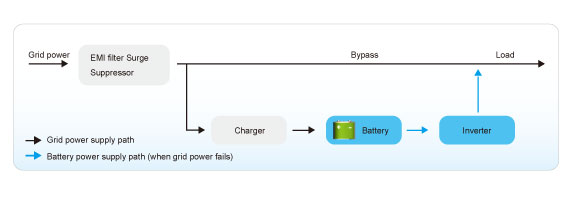
What is an On-Line UPS?
Please refer to the on-line UPS diagram.
The on-line UPS supplies power to the load by output from the inverter and uses the bypass path only in a case where the UPS itself fails, is overloaded, or overheats.
Features
1. Output power to the load is of the best quality as it is processed by the UPS.
2. No conversion time is required.
3. Complex in structure and expensive.
4. Gives the highest protection and has excellent noise filtering and surge suppression capacity.
The on-line UPS supplies power to the load by output from the inverter and uses the bypass path only in a case where the UPS itself fails, is overloaded, or overheats.
Features
1. Output power to the load is of the best quality as it is processed by the UPS.
2. No conversion time is required.
3. Complex in structure and expensive.
4. Gives the highest protection and has excellent noise filtering and surge suppression capacity.
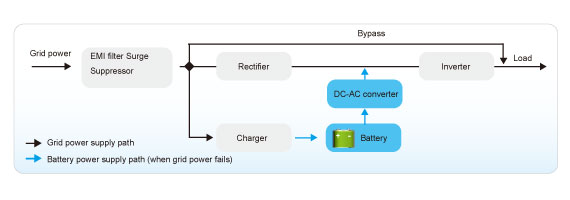
What is a Line-Interactive UPS?
Please refer to the line-interactive UPS diagram.
The line-interactive UPS supplies power to the load through the bypass path with output from the inverter when grid power is normal. The inverter acts as a charger at this time. In the event of a black out, the inverter converts DC current from the battery to AC for output to the load.
Features
1. The bi-directional conversion design reduces the time required for charging the UPS battery.
2. Requires a certain conversion time.
3. The complex control mechanism makes it more expensive.
4. Has protection capacity between that of the on-line and off-line UPSs. It is less effective in noise filtering and surge suppression.

Common battery problems
What kinds of batteries are used in a UPS?
Most commercially available UPS use sealed lead-acid batteries that are water-and maintenance-free. The energy is generated by chemical reactions in a paste-like electrolyte. For most consumers, these batteries are not only easy to use and maintain but also simple to replace when necessary.
What is the life cycle of a battery?
The power provided by a UPS comes from the discharge of its batteries. Batteries age not only with use and external factors but also from the internal chemical reactions. Batteries will still age even when not in use. Generally speaking, the average life of a lead-acid battery is 2 years.
How should a battery be maintained?
Regular charging and discharging is very important for battery maintenance. You can regularly execute this function if your UPS has the battery detection feature. Otherwise, you can simply unplug the input to your UPS to simulate a grid power black-out and check the time the battery takes to discharge. Please replace your batteries with new ones when the discharge time becomes less than that given in the specification. This will ensure that there is enough discharge time for the system to save files and be shut down in case of grid power failure.
How is the capacity of a UPS determined?
Most commercially available UPS now express their capacity as VA. V stands for voltage and A for current in amps. In short, VA equals the power and capacity of a UPS. For example, a UPS of 500VA capacity with an output of 110V will provide a maximum current of 4.55A and more than this will lead to overload. The unit of power can be expressed in Watts. While the Watt indicates active power, VA indicates reactive power and Watt equals VA multiplied by the power factor (VA × pf = Watt). There is no common criterion for power factor (pf). Generally a value of between 0.6 and 0.8 is acceptable while a value of 0.5 may represent poor design. Pay attention to this value when purchasing a UPS. A high power factor implies better utilization and more economical use of power.
Where can we have our batteries replaced?
Please contact the service center or your UPS dealer when you need to replace your batteries.
Where can an appropriate UPS be bought?
1. Learn about the applicability of each type of UPS.
2. Appraise your needs for power quality.
3. Learn the required UPS capacity and appraise the total capacity required for future expansion.
4. Select a market proven brand and supplier.
5. Purchase an appropriate UPS that is suitable for your requirements.
2. Appraise your needs for power quality.
3. Learn the required UPS capacity and appraise the total capacity required for future expansion.
4. Select a market proven brand and supplier.
5. Purchase an appropriate UPS that is suitable for your requirements.
Is a UPS really needed in places with very few black-outs?
Statistics indicate that black-outs are a minor power issue. Other, not so obvious power issues, like over-voltage, under-voltage and surges are the major ones. In addition to providing extended power for long stretches, a UPS is designed to provide customers with critical total power protection against voltage drift, surges, high frequency interference, and any other kind of power failure and drift.
How long should the UPS provide power?
The single most important function of a UPS is to provide adequate backup power for the equipment load. The time a UPS should provide power should be long enough for users to finish running reaction procedures in case of power failure. In general, 5 to 10 minutes should be enough. If longer than this is required, you can purchase a UPS that includes an external battery cabinet(s) that will increase the UPS backup time.




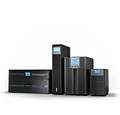

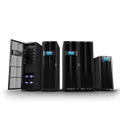
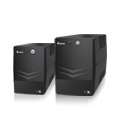
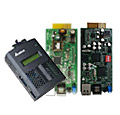

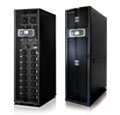
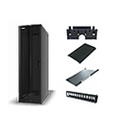

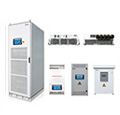
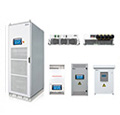
















.gif)
